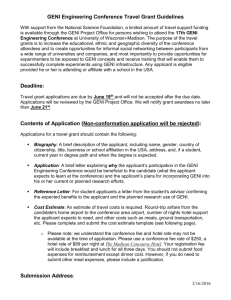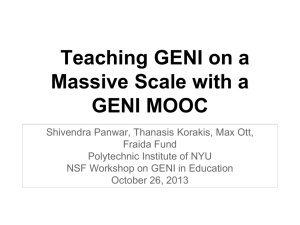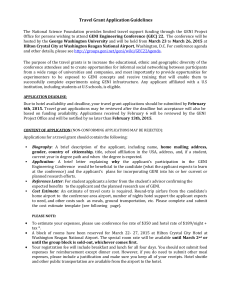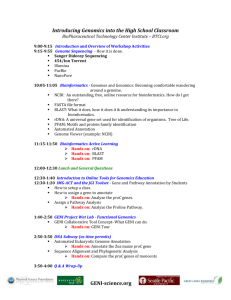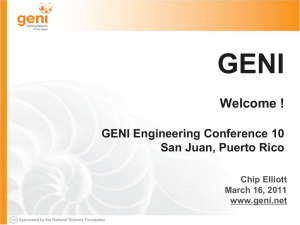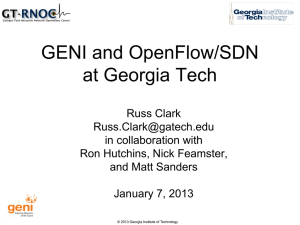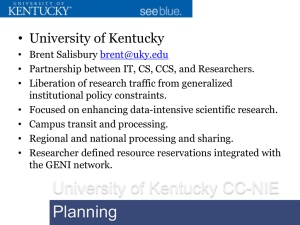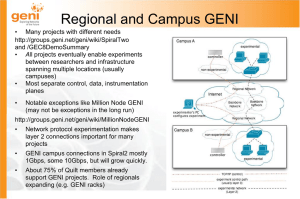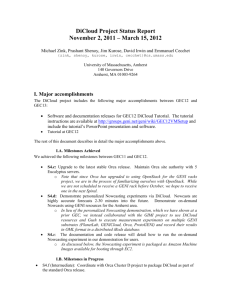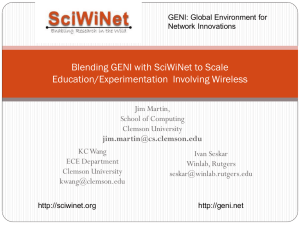Document
advertisement
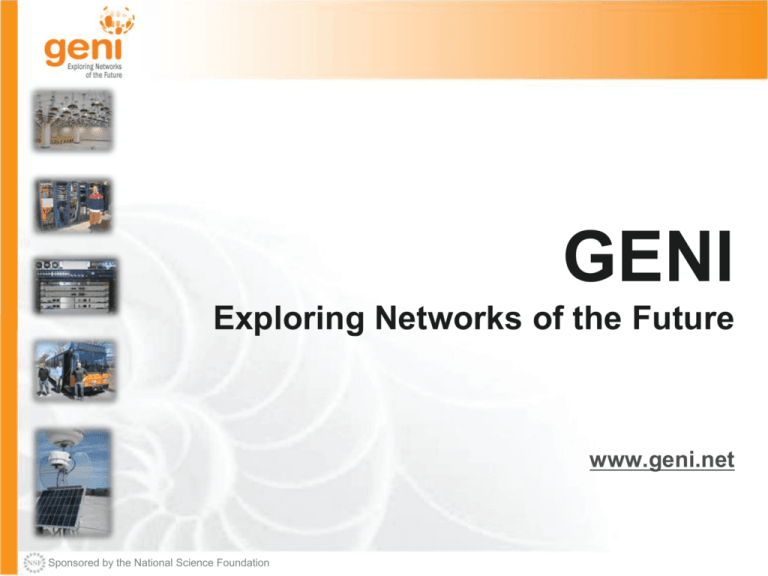
GENI Exploring Networks of the Future www.geni.net Sponsored by the National Science Foundation Outline • • • • • • GENI – Exploring future internets at scale The GENI Concept Building GENI Using GENI What’s next for GENI? GENI: An experimenter’s view Sponsored by the National Science Foundation GENI Introduction – 21 July 2013 www.geni.net 2 Global networks are creating extremely important new challenges Science Issues We cannot currently understand or predict the behavior of complex, large-scale networks Innovation Issues Substantial barriers to at-scale experimentation with new architectures, services, and technologies Society Issues Credit: MONET Group at UIUC We increasingly rely on the Internet but are unsure we can trust its security, privacy or resilience Sponsored by the National Science Foundation GENI Introduction – 21 July 2013 www.geni.net 3 What is GENI? • GENI is a nationwide suite of infrastructure for “at scale” experiments in networking, distributed systems, security, and novel applications. • GENI opens up huge new opportunities – Leading-edge research in next-generation internets – Rapid innovation in novel, large-scale applications • Key GENI concept: slices & deep programmability – Internet: open innovation in application programs – GENI: open innovation deep into the network Sponsored by the National Science Foundation GENI Introduction – 21 July 2013 www.geni.net 4 Revolutionary GENI Idea Slices and Deep Programmability Install the software I want throughout my network slice (into firewalls, routers, clouds, …) And keep my slice isolated from your slice, so we don’t interfere with each other We can run many different “future internets” in parallel Sponsored by the National Science Foundation GENI Introduction – 21 July 2013 www.geni.net 5 Outline • • • • • • GENI – Exploring future internets at scale The GENI Concept Building GENI Using GENI What’s next for GENI? GENI: An experimenter’s view Sponsored by the National Science Foundation GENI Introduction – 21 July 2013 www.geni.net 6 A bright idea I have a great idea! The original Internet architecture was designed to connect one computer to another – but a better architecture would be fundamentally based on PEOPLE and CONTENT! That will never work! It won’t scale! What about security? It’s impossible to implement or operate! Show me! Sponsored by the National Science Foundation GENI Introduction – 21 July 2013 www.geni.net 7 Trying it out My new architecture worked great in the lab, so now I’m going to try a larger experiment for a few months. And so he poured his experimental software into clouds, distributed clusters, bulk data transfer devices (‘routers’), and wireless access devices throughout the GENI suite, and started taking measurements . . . Sponsored by the National Science Foundation He uses a modest slice of GENI, sharing its infrastructure with many other concurrent experiments. GENI Introduction – 21 July 2013 www.geni.net 8 It turns into a really good idea Boy did I learn a lot! I’ve published papers, the architecture has evolved in major ways, and I’m even attracting real users! Location-based social networks are really cool! His experiment grew larger and continued to evolve as more and more real users opted in . . . Sponsored by the National Science Foundation His slice of GENI keeps growing, but GENI is still running many other concurrent experiments. GENI Introduction – 21 July 2013 www.geni.net 9 The (opt-in) user’s view Interesting new services – I just use them through an app! Good old Internet Slice 0 Slice 1 Slice 1 Slice 2 Slice 3 Slice 4 Sponsored by the National Science Foundation GENI Introduction – 21 July 2013 www.geni.net 10 Experiment turns into reality My experiment was a real success, and my architecture turned out to be mostly compatible with today’s Internet after all – so I’m taking it off GENI and spinning it out as a real company. I always said it was a good idea, but way too conservative. Sponsored by the National Science Foundation GENI Introduction – 21 July 2013 www.geni.net 11 Meanwhile . . . I have a great idea! If the Internet were augmented with a scalable control plane and realtime measurement tools, it could be 100x as robust as it is today . . . ! And I have a great concept for incorporating live sensor feeds into our daily lives ! If you have a great idea, check out the NSF CISE research programs for current opportunities. Sponsored by the National Science Foundation GENI Introduction – 21 July 2013 www.geni.net 12 Moral of this story • GENI is meant to enable . . . – At-scale experiments, which may or may not be compatible with today’s Internet – Both repeatable and “in the wild” experiments – ‘Opt in’ for real users into long-running experiments – Excellent instrumentation and measurement tools – Large-scale growth for successful experiments, so good ideas can be shaken down at scale GENI creates a huge opportunity for ambitious research! Sponsored by the National Science Foundation GENI Introduction – 21 July 2013 www.geni.net 13 Outline • • • • • • GENI – Exploring future internets at scale The GENI Concept Building GENI Using GENI What’s next for GENI? GENI: An experimenter’s view Sponsored by the National Science Foundation GENI Introduction – 21 July 2013 www.geni.net 14 Growing GENI’s footprint (as proposed; actual footprint to be engineered) Sponsored by the National Science Foundation GENI Introduction – 21 July 2013 www.geni.net 15 Federation GENI grows by “GENI-enabling” heterogeneous infrastructure My experiment runs across the evolving GENI federation. Campus #3 Commercial Clouds Backbone #1 Campus My GENI Slice Access #1 Research Testbed Backbone #2 NSF parts of GENI Other-Nation Projects Corporate GENI suites This approach looks remarkably familiar . . . Campus #2 Goals: avoid technology “lock in,” add new technologies as they mature, and potentially grow quickly by incorporating existing infrastructure into the overall “GENI ecosystem” Sponsored by the National Science Foundation GENI Introduction – 21 July 2013 www.geni.net 16 Enabling “at scale” experiments • How can we afford / build GENI at sufficient scale? – Clearly infeasible to build research testbed “as big as the Internet” – Therefore we are “GENI-enabling” testbeds, commercial equipment, campuses, regional and backbone networks – Students are early adopters / participants in at-scale experiments – Key strategy for building an at-scale suite of infrastructure HP ProCurve 5400 Switch NEC WiMAX Base Station GENI-enabled equipment GENI-enabled campuses, students as early adopters Sponsored by the National Science Foundation “At scale” GENI prototype GENI Introduction – 21 July 2013 Campus photo by Vonbloompasha www.geni.net 17 Georgia Tech: a great example One of the first 14 GENI-enabled campuses • OpenFlow in 4 GT lab buildings now • OpenFlow/BGPMux coursework now Nick Feamster Ellen Zegura PI Russ Clark, GT-RNOC • Dormitory trial • Students will “live in the future” – Internet in one slice, multiple future internets in additional slices Ron Hutchins, OIT Trials of “GENI-enabled” commercial equipment Toroki LightSwitch 4810 HP ProCurve 5400 Switch Juniper MX240 Ethernet Services Router NEC WiMAX Base Station HTC Android smart phone Arista 7124S Switch NEC IP8800 Ethernet Switch Sponsored by the National Science Foundation GENI Introduction – 21 July 2013 GENI racks www.geni.net 18 Envisioned architecture UNI VERSI T Y ISP Internet Metro Research Backbones g GENI-enabled hardware Legend Layer 2 Data Plane Layer 3 Control Plane g UNI VERSI T Y Regional Networks Campus g • Flexible network / cloud research • Support “hybrid circuit” model plus infrastructure much more (OpenFlow) • Also suitable for physics, • Distributed cloud (racks) for content genomics, other domain science caching, acceleration, etc. Sponsored by the National Science Foundation GENI Introduction – 21 July 2013 www.geni.net 19 Current efforts in GENI buildout • More WiMAX base stations with Android handsets • GENI-enable 5-6 regional networks • Inject more GENI Racks serve as programmable routers, distributed clouds, content OpenFlow switches distribution nodes, caching or transcoding nodes, etc into Internet2 and NLR • Add GENI Racks to 50-80 locations within campuses, regionals, and backbone networks Sponsored by the National Science Foundation GENI Introduction – 21 July 2013 www.geni.net 20 Creating and deploying GENI racks Ilia Baldine RENCI More resources / rack, fewer racks Rick McGeer HP Labs Fewer resources / rack, more racks ExoGENI Rack Installed at GPO – Feb 22, 2012 Sponsored by the National Science Foundation GENI Introduction – 21 July 2013 www.geni.net 21 ExoGENI racks • 14 GPO-funded racks – Partnership between RENCI, Duke and IBM – IBM x3650 M3/M4 servers • • • • 1x146GB 10K SAS hard drive +1x500GB secondary drive 48G RAM Dual-socket 8-core CPU w/ Sandy Bridge 10G dual-port Chelseo adapter – BNT 8264 10G/40G OpenFlow switch – DS3512 6TB sliverable storage • iSCSI interface for head node image storage as well as experimenter slivering • Each rack is a small networked cloud – OpenStack-based – EC2 nomenclature for node sizes (m1.small, m1.large etc) – Interconnected by combination of dynamic and static L2 circuits through regionals and national backbones • http://wiki.exogeni.net Sponsored by the National Science Foundation GENI Introduction – 21 July 2013 www.geni.net 22 InstaGENI racks Sponsored by the National Science Foundation GENI Introduction – 21 July 2013 www.geni.net 23 GENI WiMAX deployments (1 of 2) Sponsored by the National Science Foundation GENI Introduction – 21 July 2013 www.geni.net 24 GENI WiMAX deployments (2 of 2) Sponsored by the National Science Foundation GENI Introduction – 21 July 2013 www.geni.net 25 Example regional network CENIC OpenFlow buildout Sponsored by the National Science Foundation GENI Introduction – 21 July 2013 www.geni.net 26 GENI / Internet2 Agreement A major step towards campus expansion • Collaboration to implement national-scale infrastructure – sliced and deeply-programmable – incorporating OpenFlow/SDN switches, GENI Racks, university datacenters, etc. – high-speed (10-100 Gbps initially) • With software that supports shared use by faculty, students, and campus IT organizations • Gradual migration from today’s “prototype GENI” backbone in Internet2 to a real, production system • Scaling to an envisioned goal of 100-200 GENI campuses Opens the door for “at-scale” GENI ! Note that this agreement does not exclude either party from additional collaborations. Sponsored by the National Science Foundation GENI Introduction – 21 July 2013 www.geni.net 27 Outline • • • • • • GENI – Exploring future internets at scale The GENI Concept Building GENI Using GENI What’s next for GENI? GENI: An experimenter’s view Sponsored by the National Science Foundation GENI Introduction – 21 July 2013 www.geni.net 28 Rapid growth in experimentation Sponsored by the National Science Foundation GENI Introduction – 21 July 2013 www.geni.net 29 Continued Rapid Increase in Numbers of Experiments Sponsored by the National Science Foundation GENI Introduction – 21 July 2013 www.geni.net 30 ActiveCDN Columbia University Program content distribution services deep into the network, adapt distribution in real time as demand shifts ActiveCDN ActiveCDN GPO Utah Kansas Clemson Benefits of ActiveCDN: • • Dynamic deployment based on load Localized services such as weather, ads and news Sponsored by the National Science Foundation Jae Woo Lee, Jan Janak, Roberto Francescangeli, SumanSrinivasan, Eric Liu, Michael Kester, SalmanBaset, Wonsang Song, and Henning Schulzrinne Real-Time Lab, Columbia University GENI Introduction – 21 July Internet 2013 www.geni.net 31 ViSE views steerable radars as shared, virtualized resources http://geni.cs.umass.edu/vise David Irwin et al Weather NowCasting University of Massachusetts Generate “raw” live data ViSE/CASA radar nodes http://stb.ece.uprm.edu/current.jsp Create and run realtime “weather service on demand” as storms turn life-threatening Nowcast images for display 1. “raw” live data Spin up system in Amazon commercial EC2 and S3 services on demand Multi-radar NetCDF Data Nowcast Processing Sponsored by the National Science Foundation GENI Introduction – 21 July 2013 www.geni.net 32 Aster*x Load Balancing (OpenFlow) Stanford University Nikhil Handigol et al, Stanford Univ. Program realtime load-balancing functionality deep into the network itself Sponsored by the National Science Foundation GENI Introduction – 21 July 2013 www.geni.net 33 MobilityFirst: Rutgers et al. Nikhil Handigol et al, Stanford Univ. MF Arch is designed to meet emerging mobile/wireless service requirements at scale Sponsored by the National Science Foundation GENI Introduction – 21 July 2013 www.geni.net 34 eXpressive Internet Architecture (XIA) CMU, BU, Wisconsin Nikhil Handigol et al, Stanford Univ. XIA exploring three concepts to address issues: • Diverse types of end-points • Intrinsic security • Flexible addressing Sponsored by the National Science Foundation GENI Introduction – 21 July 2013 www.geni.net 35 Workshops and journals Using GENI for research and education • Sigmetrics 2012 • Kaiqi Xiong, RIT – GENI Research and Educational Experiment Workshop – March 2013 – Second Summer Camp -June 2013 • 4.5 days of tutorials, advice, oneon-one support • Jeannie Albrecht, Williams – Curricula for Undergraduate Courses in Distributed Systems • Nick Feamster, GA Tech – “Living lab” – being planned – Tutorial on GENI • TridentCom 2012 – Testbeds, Experimentation and Innovation for the Future Internet • SIGCSE 2013 – Tutorial on GENI • NSDI 2013 – Tutorial on GENI • ICDCS 2013 – Tutorial on GENI Special issue on Future Internet Testbeds – Computer Networks, James P. G. Sterbenz et al, eds. Sponsored by the National Science Foundation GENI Introduction – 21 July 2013 www.geni.net 36 The New “Key GENI Concepts” Page Sponsored by the National Science Foundation GENI Introduction – 21 July 2013 www.geni.net 37 Instructors are Using GENI in the Classroom • Spring 2013: – – – – Jay Aikat (U. of NC) 2 classes at NCSU (including a seminar class by Rudra) Jelena Marasevic (Columbia U) Parmesh Ramanathan (U. Wisc) – Violet Syrotiuk (Arizona State U.) – KC Wang (Clemson) – Mike Zink (UMass) • Planed for Fall 2013 – – – – Zongming Fei (U. of KY) Christos Papadopoulos (Col. State) Zhi-Li Zhang (U. of MN) Michael Zink (UMass) Sponsored by the National Science Foundation GENI Introduction – 21 July 2013 www.geni.net 38 US Ignite • US Ignite is an initiative to spark the development of gigabit applications and services • in areas of national priority: advanced manufacturing, health, education, energy, economic development, transportation, and public safety/emergency preparedness • on an ultra high speed, deeply programmable, and sliceable network testbed. Sponsored by the National Science Foundation GENI Introduction – 21 July 2013 www.geni.net 39 US Ignite is now taking shape Bridging CS Experiments to Next-Gen Applications in Cities GENI US Ignite Research Infrastructure for Computer Scientists Public-Private Partnership for Next-Gen Applications Future commercial offerings federation GENI technology GENI members, policies, … US Ignite members, policies, … Campus and Lab App creation teams Applied Research CS Research CS Experiments Pre-commercial Applications Experimental Usage and Demonstrations Campus networks Service creators Commercial Applications Municipal and commercial networks Regional and backbone networks US Ignite is a new organization that will promote advanced applications and infrastructure leveraging GENI research and technologies. Sponsored by the National Science Foundation GENI Introduction – 21 July 2013 www.geni.net 40 Looking forward Growing to the “at scale” GENI • Suggest 100-200 US campuses as target for “at scale” – Both academia and national labs – GENI-enable the campuses – Their students, faculty, staff can then “live in the future” using both today’s Internet and many experiments – Build out backbones, regionals, and shared clouds to support the campuses • Grow via ongoing spiral development – Identify, understand, and drive down risks – Learn what is useful and what is not – Early GENI campuses can help later ones • Transition to community governance Sponsored by the National Science Foundation GENI Introduction – 21 July 2013 www.geni.net 41 Outline • • • • • • GENI – Exploring future internets at scale The GENI Concept Building GENI Using GENI What’s next for GENI? GENI: An experimenter’s view Sponsored by the National Science Foundation GENI Introduction – 21 July 2013 www.geni.net 42 Growing GENI to 100-200 campuses GENI racks, OpenFlow, WiMAX, training, ops Solicitation 3 efforts 14 30 100? 200? Campus expansions GENI racks, OpenFlow, WiMAX, training, ops Spiral development . . . Sponsored by the National Science Foundation GENI Introduction – 21 July 2013 www.geni.net 43 GENI campus expansion Dr. Larry Landweber, U. Wisconsin • “GENI-enabled” means . . . OpenFlow + GENI racks, plus WiMAX on some campuses Sponsored by the National Science Foundation • Current GENI campuses Clemson, Colorado, Columbia, Georgia Tech, Indiana, Princeton, Kansas State, NYU Poly, Rutgers, Stanford, UCLA,U MA Amherst, U Washington, U Wisconsin • CIO Initiative - 19 campuses Case Western, Chicago, Colorado, Cornell, Duke, Florida International, U Kansas, Michigan, NYU, Purdue, Tennessee, U FLA, University of Houston, UIUC, U MA Lowell-Amherst, Utah, Washington, Wisconsin • Rapidly growing waitlist GENI Introduction – 21 July 2013 www.geni.net 44 Ramping up experimenter workshops and training sessions for IT staff • GPO funding 3 workshops / year by Indiana University • Goal: train IT staff on OpenFlow and (when available) GENI racks • At GEC 12 in Kansas City: Network Engineers “boot camp” organized by Larry Landweber and given by Matt Davy and Steve Wallace, Indiana University Sponsored by the National Science Foundation • 35 additional schools have expressed interest and are on waitlist GENI Introduction – 21 July 2013 www.geni.net 45 GENI’s international peers K-GENI G-LAB JGN-X FIRE CERNET2 Brazil NICTA The GENI project is actively collaborating with peer efforts outside the US, based on equality and arising from direct, “researcher to researcher” collaborations. Sponsored by the National Science Foundation GENI Introduction – 21 July 2013 www.geni.net 46 Outline • • • • • • • GENI – Exploring future internets at scale The GENI Concept Building GENI Using GENI GENI and US Ignite What’s next for GENI? GENI: An experimenter’s view Sponsored by the National Science Foundation GENI Introduction – 21 July 2013 www.geni.net 47 GENI: Terms and Definitions • Slice: Abstraction for a collection of resources capable of running experiments – An experiment uses resources in a slice – Slices isolate experiments – Experimenters are responsible for their slices Sponsored by the National Science Foundation GENI Introduction – 21 July 2013 www.geni.net 48 GENI: Terms and Definitions • Slice authority: Creates and registers slices – GENI slice authorities: PlanetLab, ProtoGENI, GPO Lab • Aggregate: Provides resources to GENI experimenters – Typically owned and managed by an organization – Examples: PlanetLab, Emulab, GENI Rack on various campuses – Aggregates implement the GENI AM API Create & Register Slice Slice Authority Slice credentials Aggregate Manager API Researcher Sponsored by the National Science Foundation - listResources - createSliver … GENI Introduction – 21 July 2013 Aggregate Manager Aggregate Resources www.geni.net 49 GENI: Terms and Definitions • Sliver: One or more resources provided by an aggregate – E.g. Bare machines, virtual machines, VLANs Campus #3 My slice contains slivers from many aggregates. Commercial Clouds Backbone #1 Campus My GENI Slice Access #1 Research Testbed Corporate GENI suites Backbone #2 Other-Nation Projects Campus #2 Sponsored by the National Science Foundation GENI Introduction – 21 July 2013 www.geni.net 50 RSpecs • RSpecs: Lingua franca for describing and requesting resources – “Machine language” for negotiating resources between experiment and aggregate – Experimenter tools eliminate the need for most experimenters to write or read RSpec <?xml version="1.0" encoding="UTF-8"?> <rspec xmlns="http://www.protogeni.net/resources/rspec/2" xmlns:xsi="http://www.w3.org/2001/XMLSchema-instance" xsi:schemaLocation="http://www.protogeni.net/resources/rspec/2 http://www.protogeni.net/resources/rspec/2/request.xsd" type="request" > <node client_id="my-node" exclusive="true"> <sliver_type name="raw-pc" /> </node> </rspec> RSpec for requesting a single node Sponsored by the National Science Foundation GENI Introduction – 21 July 2013 www.geni.net 51 Sliver Creation using Rspecs and the AM API • Advertisement RSpec: What does an aggregate have? • Request RSpec: What does the experimenter want? • Manifest RSpec: What does the experimenter have? ListResources(…) Advertisement RSpec Client CreateSliver(Request RSpec, …) Manifest RSpec Aggregate Manager ListResources(SliceName, …) Manifest RSpec Sponsored by the National Science Foundation GENI Introduction – 21 July 2013 www.geni.net 52 Putting it all Together: Demo • Demo – Create a slice – Create a sliver at one aggregate • Two computers (raw PCs), connected by a LAN server (raw PC) client (raw PC) – Install and run software on the machines – View output of software – Delete sliver • Experimenter tool: Flack Sponsored by the National Science Foundation GENI Introduction – 21 July 2013 www.geni.net 53 Start Demo • • • • • • Login to GENI Experimenter Portal Create slice Launch Flack Draw topology Create sliver Verify sliver creation was successful Sponsored by the National Science Foundation GENI Introduction – 21 July 2013 www.geni.net 54 The Demo Experiment in Flack Sponsored by the National Science Foundation GENI Introduction – 21 July 2013 www.geni.net 55 The Request Rspec <rspec type="request” xsi:schemaLocation=“http://www.geni.net/resources/rspec/3 http://www.geni.net/resources/rspec/3/request.xsd” xmlns:xsi="http://www.w3.org/2001/XMLSchema-instance" xmlns="http://www.geni.net/resources/rspec/3"> <node client_id="server" component_manager_id="urn:publicid:IDN+emulab.net+authority+cm" exclusive="true"> <sliver_type name="raw-pc"> <disk_image name="urn:publicid:IDN+emulab.net+image+emulab-ops//FEDORA10-STD"/> </sliver_type> <services> <execute command="sudo /local/install-script.sh" shell="sh"/> <install install_path="/local" url="http://www.gpolab.bbn.com/experiment-support/HelloGENI//hellogeni-install.tar.gz"/> </services> <interface client_id="server:if0” /> </node> <node client_id="client" component_manager_id="urn:publicid:IDN+emulab.net+authority+cm" exclusive="false"> <sliver_type name="emulab-openvz"/> <services> <execute command="sudo /local/install-script.sh" shell="sh"/> <install install_path="/local" url="http://www.gpolab.bbn.com/experiment-support/HelloGENI//hellogeni-install.tar.gz"/> </services> <interface client_id="client:if0” /> </node> <link client_id="Lan"> <component_manager name="urn:publicid:IDN+emulab.net+authority+cm"/> <interface_ref client_id="server:if0"/> <interface_ref client_id="client:if0"/> <property source_id="server:if0" dest_id="client:if0"/> <property source_id="client:if0" dest_id="server:if0"/> </link> </rspec> Sponsored by the National Science Foundation GENI Introduction – 21 July 2013 www.geni.net 56 The Manifest Rspec <rspec type="manifest" …> <node client_id="server" component_manager_id="urn:publicid:IDN+emulab.net+authority+cm" exclusive="true" component_id="urn:publicid:IDN+emulab.net+node+pc554" sliver_id="urn:publicid:IDN+emulab.net+sliver+95506"> <sliver_type name="raw-pc"> <disk_image name="urn:publicid:IDN+emulab.net+image+emulab-ops//FEDORA10-STD"/> </sliver_type> <services> <execute command="sudo /local/install-script.sh" shell="sh"/> <install install_path="/local" url="http://www.gpolab.bbn.com/experiment-support/HelloGENI//hellogeni-install.tar.gz"/> <login authentication="ssh-keys" hostname="pc554.emulab.net" port="22" username="vthomas"/> </services> <interface client_id="server:if0" component_id="urn:publicid:IDN+emulab.net+interface+pc554:eth2" sliver_id="urn:publicid:IDN+emulab.net+sliver+95509" mac_address="0024e87a46fb"> <ip address="10.10.1.1" type="ipv4"/> </interface> </node> <node client_id="client" component_manager_id="urn:publicid:IDN+emulab.net+authority+cm" exclusive="false" component_id="urn:publicid:IDN+emulab.net+node+pc533" sliver_id="urn:publicid:IDN+emulab.net+sliver+95505"> <sliver_type name="emulab-openvz"/> <services> <execute command="sudo /local/install-script.sh" shell="sh"/> <install install_path="/local" url="http://www.gpolab.bbn.com/experiment-support/HelloGENI//hellogeni-install.tar.gz"/> <login authentication="ssh-keys" hostname="pc533.emulab.net" port="37178" username="vthomas"/> </services> <interface client_id="client:if0" component_id="urn:publicid:IDN+emulab.net+interface+pc533:eth2" sliver_id="urn:publicid:IDN+emulab.net+sliver+95510" mac_address="0262331adfd4"> <ip address="10.10.1.2" type="ipv4"/> </interface> </node> <link client_id="Lan" sliver_id="urn:publicid:IDN+emulab.net+sliver+95508" vlantag="310"> <interface_ref client_id="server:if0" component_id="urn:publicid:IDN+emulab.net+interface+pc554:eth2" sliver_id="urn:publicid:IDN+emulab.net+sliver+95509"/> <interface_ref client_id="client:if0" component_id="urn:publicid:IDN+emulab.net+interface+pc533:eth2" sliver_id="urn:publicid:IDN+emulab.net+sliver+95510"/> <property source_id="server:if0" dest_id="client:if0"/> <property source_id="client:if0" dest_id="server:if0"/> </link> Sponsored by the National Science Foundation GENI Introduction – 21 July 2013 www.geni.net 57 Do Try This at Home! • Tutorials on the GENI wiki – Look for the icon on the GENI wiki and then click on for tutorials • Participate in the hands-on tutorials at the GEC • Get a GENI account today! Sponsored by the National Science Foundation GENI Introduction – 21 July 2013 www.geni.net 58 Get a GENI Account Today! At the GEC: - Experimenter Help Desk - Experimenter drop-in on Mon - Coding sprint on Tue Online: https://portal.geni.net Email: help@geni.net Student need a professor to create a GENI project Sponsored by the National Science Foundation GENI Introduction – 21 July 2013 www.geni.net 59 Participate in the Hands-On Tutorials! Some tutorials require pre-work. Sponsored by the National Science Foundation GENI Introduction – 21 July 2013 www.geni.net 60 GENI Engineering Conferences We welcome your participation in GENI • 18th meeting, open to all: October 27-29, 2013, NYU Poly - Brooklyn – Planning & discussion for experimenters, software, infrastructure – Tutorials and workshops (plus Mozilla hackfest) – Travel grants to US academics for participant diversity Sponsored by the National Science Foundation GENI Introduction – 21 July 2013 www.geni.net 61 QUESTIONS? Sponsored by the National Science Foundation GENI Introduction – 21 July 2013 www.geni.net 62
